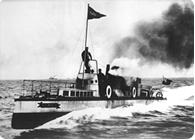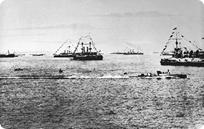
|
|
||||||||
Charles Algernon Parsons
|
At the same time he worked on marine steam turbines. Parsons began his experiments using a 2ft model boat towed by a fishing rod, and scaled these up to a full sized ship, the Turbinia in 1894. Ewing took part in these trials. It is reported that the Turbinia gate-crashed the Spithead review in 1897. Immediately after the Royal inspection of the fleet by Queen Victoria, the Turbinia appeared, weaving in and out of the warships at a speed of 30 knots, uncatchable. The bold crew consisted of the Director of Parsons Marine Steam Turbine Company, Alan Campbell-Swinton with Charles Parsons, FRS as chief engineer, and Dr Gerald Stoney, FRS stoking up the boilers in the engine rooms. |
Turbina weaving between the warships |
The Turbinia reached a speed of 34 knots, when the fastest destroyers of the day only managed 27. This was due to the success of two innovations both the steam turbine for ship propulsion, and the slender hull. The latter design detail was revived by John Wishart in 1997 for his ship 'Cable and Wireless' when he made an attempt to circumnavigate the globe in under 80 days in a powered vessel.

